The days of commercial fishing in the Hudson River, as Gil Hawkins put it, are long gone.
Hawkins, the president of the Hudson River Fishermen”™s Association, a nonprofit whose mission is to bring the river back to prominence, said years of PCB-laden chemical dumping by General Electric into the river have made commercial fishing unviable for nearly five decades. That, and there isn”™t much money to be made in the industry in the Hudson.
Recreational catch-and-release fishing in the river, however, has become the main selling point for Hawkins and the 300 members of the association, who fish from the Verrazano Bridge to the Troy Dam. Through sustainable cleanup efforts and partnerships with area businesses, the association has promoted the Hudson as not just a recreational destination but also an economic one.
“We”™re working to get families back to the river,” Hawkins said. “We”™re hoping people will use the river for its parks, restaurants and marinas.”
Though the group formed in 1966 and most of its efforts have centered around pollution issues in the Hudson ”” it is the parent organization of environmental advocacy group Riverkeeper ”” the association has turned much of its efforts toward the local fishing and boating industries, which were ravaged by the 2008 recession and hurricanes Sandy and Irene.
Storm surge from the hurricanes severely damaged ”” in some cases, wiped out ”” marinas up and down the Hudson. During the recession, Hawkins said, many boat owners abandoned or sold off their boats rather than pay for upkeep and other related costs. Bait-and-tackle shops along the river, which at one point totaled in the dozens, closed their doors due to declining business and big-box competition.
“Recreational use of the river took a big hit,” Hawkins said.”We”™re hoping people can recognize the river not only as a part of our culture but also our economic well-being.”
Skip Storch, president of Shu-Fly Tackle & Fly Shop in Nanuet, one of the few mom-and-pop tackle shops left in the region, said he sees customers who fish as close as the Hudson but also those from neighboring states. Storch, also an International Swimming Hall of Fame member, said his shop strives to differentiate itself from the larger competition through intangibles and knowledge of the sport.
“Their business is driven by prices,” Storch said. “Ours is by service.”
Since 2013, the Fishermen”™s Association has partnered with Billy Joe”™s restaurant in Newburgh to host an annual striped bass fishing contest with cash prizes going to those with the highest-scoring catches.
That year, the organization held two fishing contests. This year, it”™s scheduled to host five in the region.
In May, the association held its annual Hooked on the Hudson contest in Fort Lee, New Jersey, where fishing rods were awarded to the top youth fishers.
Hosting events to get the area”™s youths involved in the sport is a main goal of the organization. The more young people that become interested in fishing, the brighter the future looks for the sport. And with more participants in the sport, the more economic benefit area shops and riverfront businesses will see from parents who purchase bait or fishing rods or eat at a riverfront restaurant after a day at the Hudson.
The organization”™s next contest, on July 14, will be held in Catskill before a fall contest in Croton. Hawkins said he is also working on a partnership with the Hudson River Maritime Museum in Kingston.
“Parents can see the river is a viable recreational and healthy outlet for family activity,” Hawkins said. “Even though we can”™t say we can safely eat the fish, we can say we had a great time on the river.”
According to state Department of Environmental Conservation”™s Tidal Hudson River regulations, fishers may catch one striped bass per day. Open season for the fish runs from April through November. The limit on hickory shad, another popular Hudson species, is five per day. Anyone selling striped bass caught in the Hudson would be in direct violation of DEC laws.
Hawkins, who likened the Fishermen”™s Association to a watchdog organization, said its other main goal is to protect the historic river from polluters, which can range from individuals to companies to municipalities, and to promote the sustainable work of others.
In 1997, the town of Cortlandt restored Verplanck”™s Steamboat Riverfront Park to include a fishing pier for both conventional fishing and crabbing. Five years prior to the rededication, a $5.8 million Hudson striped bass hatchery was built on the grounds of a former Con Edison plant in Verplanck as part of a settlement between government agencies and companies that operated plants along the river.
According to Nick Karas”™ “The Complete Book of Striped Bass Fishing,” General Electric dumped more than 660,000 pounds of PCBs into the Hudson from two of its plants near Troy in the 20th century.
As part of its $7 million renovated Waterfront Park opened last month, Dobbs Ferry launched its own fishing pier.
Hawkins mentioned that Verplanck is now one of the more popular fishing spots in the area, as well as Yonkers and Croton, where the Fishermen”™s Association got started 49 years ago.
“Any community seriously interested in promoting the Hudson River as a recreation fishing area, we will come and work with you to establish a viable fishing program,” he said.


















